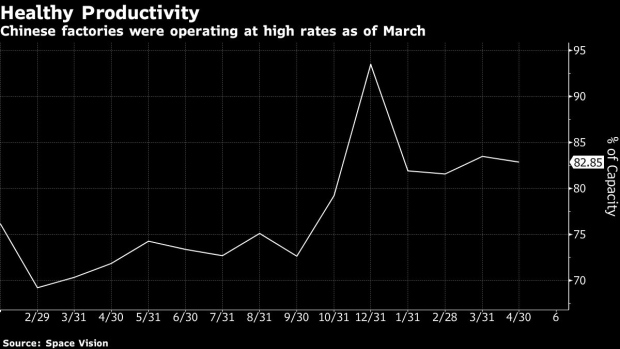May 12, 2021
Robust Chinese Fuel Demand Cushioning Oil Market Once Again
, Bloomberg News

(Bloomberg) -- China’s rapid rebound from the Covid-19 pandemic last year helped pull the global oil market out of its downward spiral and put it on a path to recovery. With the coronavirus once again flaring up across Asia, the region’s biggest economy is acting as a bulwark once again.
Fuel consumption has risen as domestic travel picks up across China, with residents confident localized outbreaks will be dealt with swiftly. The nation is also forecast to import more crude this year than in 2020 due to the economic recovery, as well as a steady expansion of refining capacity. Here are four charts showing the impact of accelerating Chinese energy demand.
Fuel Frenzy
Booming holiday travel and greater mobility has pushed motor fuel prices back to pre-pandemic levels. Wholesale gasoline rose to the highest since September 2019 late last month, data from the National Bureau of Statistics show. On the first day of the three-day ‘Tomb-Sweeping’ break in early April, people made more than 34 million road trips, marginally lower than the same period two years ago, the government said in a statement.
The Labor Day holiday that stretched over five days from May 1 saw bookings for seats on planes, hotel rooms and car rentals surge. Some travelers were even forced to drive long distances to reach their destinations after tickets for preferred options such as rail sold out.
Stockpiles Slide
Greater fuel use is helping to drain crude stockpiles at ports in Shandong, the province where most of China’s independent refiners are clustered. Inventories were at 45.4 million barrels as of April 30, near the lowest level since February, according to industry consultant SCI99. Private processors have also been seeking to reduce supplies as they undertake maintenance.
A more broader view of Chinese stockpiles monitored by satellite company Ursa Space Systems showed inventories falling to 951 million barrels as of April 29, or around 69% of capacity, down from an October record of 73%.
Healthy Margins
Reduced refining due to planned maintenance has tightened fuel supply and combined with rising demand to boost profit margins for the nation’s private processors, known as teapots. Margins rose to 487 yuan ($75.76) a ton in mid-April, the highest this year, and has held steady around that level since.
The outlook for the market is bullish and margins are likely to stay high, said Yuntao Liu, an analyst at Energy Aspects Ltd. A crackdown on lower quality fuels may tighten the market further and boost profits for refiners, Liu said.
Factories Firing
Demand is also benefiting from surging industrial activity, with factories in China’s 143 industrial parks ramping up this year as the economic recovery gathers pace. Operating rates were at almost 83% of capacity at the end April, up from about 72% at the same time last year and around 68% in 2019, according to Shenzhen-based data provider Space Vision.
However, China’s factory-gate prices surged more than expected in April, fueled by rapid gains in commodity prices. The broader boom in raw materials, driven by rising global demand and supply shortages, has stoked concerns about inflation around the world.
China’s economy strengthened in the first quarter of the year as consumer spending rose more than expected, putting it on course to join the U.S. as twin engines for a global recovery in 2021.
(Updates with inflation fears in 10 paragraph.)
©2021 Bloomberg L.P.


